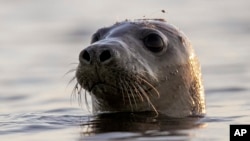Scientists believe they have found a new use for facial recognition technology: saving large ocean animals known as seals.
Researchers at Colgate University in the U.S. state of New York have developed SealNet. The system is a database of seal faces created by taking pictures of many harbor seals in Maine’s Casco Bay.
The research team found the tool’s accuracy in identifying the mammals was close to 100 percent.
The researchers are working on increasing the size of their database to make it available to other scientists, said Krista Ingram. She is a biology professor at Colgate and a team member.
Increasing the database to include rare species such as the Mediterranean monk seal and Hawaiian monk seal could help efforts to save those species, she said.
Creating a list of seal faces and using machine learning to identify them can also help scientists know where in the ocean seals are, Ingram said.
She said, “For...marine mammals that move around a lot and are hard to photograph in the water, we need to be able to identify individuals.”
SealNet is designed to identify the face in a picture. It recognizes the seal’s face based on information related to the eyes and nose shape, as it would a human. A similar tool called PrimNet, that is for use on primates, had been used on seals earlier, but SealNet performed better, the Colgate researchers said.
The Colgate team published its findings last spring in Ecology and Evolution. They processed more than 1,700 images of more than 400 individual seals, the paper said.
The paper stated that the SealNet software could be a valuable tool in the developing field of “conservation technology” - technology aimed at saving and protecting wild animals.
Harbor seals are a conservation success story in the U.S. More than 100 years ago, the animals were once widely killed. But the Marine Mammal Protection Act, which turned 50 in October, gave them new protections — and populations began to come back.
Seals and other ocean mammals have long been studied using satellite technology. Using artificial intelligence to study them is a way to bring conservation into the 21st century, said Jason Holmberg of Wild Me. The Oregon-based company works to bring machine learning to biologists. Wild Me is developing a possible partnership with SealNet.
Harbor seals are now common in the waters off the coast of the Northeastern United States. Other seal species, however, remain at risk. The Mediterranean monk seal is thought to be the world’s most at-risk seal with only a few hundred animals remaining.
Facial recognition technology could provide valuable data, said Michelle Berger, an associate scientist at the Shaw Institute in Maine. Berger was not involved in the SealNet research.
“Once the system is perfected I can picture lots of interesting” environmental uses for it, Berger said. “If they could recognize seals, and recognize them from year to year, that would give us lots of information about movement, how much they move from site to site.”
The Colgate researchers are also working with FruitPunch, a Dutch artificial intelligence company, to improve some parts of SealNet to help more scientists use it, said Tjomme Dooper, FruitPunch’s head of partnerships and growth.
That would open new opportunities to study the animals and help protect them, he said.
“What this does is help the biologists study the behavior of seals, and also population dynamics,” Dooper said. He added that harbor seals give important information about the environment around them.
I’m John Russell.
Patrick Whittle reported on this story for the Associated Press. John Russell adapted it for VOA Learning English.
__________________________________________________________________
Words in This Story
species – n. biology : a group of animals or plants that are similar and can produce young animals or plants
accuracy –n. freedom from error or mistakes
primate – n. any member of the group of animals that includes human beings, apes, and monkeys
conservation – n. the protection of animals, plants, and natural resources
artificial intelligence –n. an area of computer science that deals with giving machines the ability to seem like they have human intelligence
dynamics – n. the way that two or more people or things behave with each other because of a particular situation












Forum